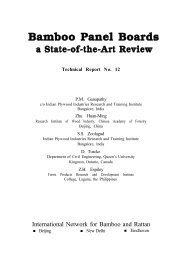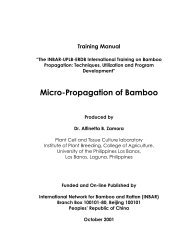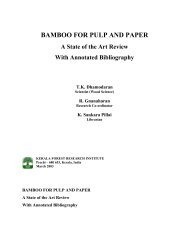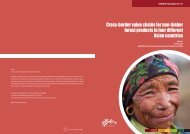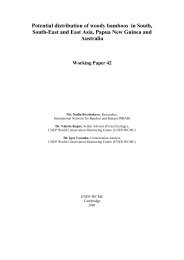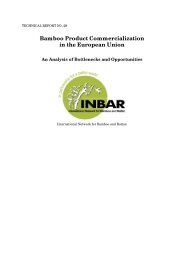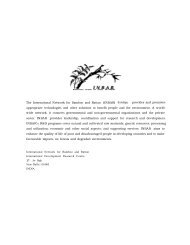The Bamboo and Rattan Sectors in Asia: an Analysis of ... - INBAR
The Bamboo and Rattan Sectors in Asia: an Analysis of ... - INBAR
The Bamboo and Rattan Sectors in Asia: an Analysis of ... - INBAR
Create successful ePaper yourself
Turn your PDF publications into a flip-book with our unique Google optimized e-Paper software.
A large amount <strong>of</strong> bamboo also 'leaks' to private traders. <strong>The</strong> largest source<br />
seems to be head-load pass holders. <strong>The</strong> private traders are will<strong>in</strong>g <strong><strong>an</strong>d</strong> able to give<br />
adv<strong>an</strong>ce payments for the bamboo. <strong>The</strong>y are perceived to be more trustworthy, <strong><strong>an</strong>d</strong><br />
they pay more quickly <strong><strong>an</strong>d</strong> on better terms th<strong>an</strong> KSBC. Hence, the head-load pass<br />
holders <strong><strong>an</strong>d</strong> other cutters divert some <strong>of</strong> their produce to private traders.<br />
<strong>The</strong> weavers obta<strong>in</strong> their raw material through the KSBC. <strong>The</strong>re are separate<br />
Mat Depot <strong><strong>an</strong>d</strong> sub-depots that arr<strong>an</strong>ge adequate supplies <strong>of</strong> reed from the RCCs <strong><strong>an</strong>d</strong><br />
distribute reeds to registered weavers. <strong>The</strong> reeds are 'adv<strong>an</strong>ced' to the weavers, who<br />
take the woven mats back to the depot for sale, at which time the value <strong>of</strong> the<br />
adv<strong>an</strong>ced raw material is deducted from the payment. <strong>The</strong> Mat Depots are also<br />
responsible to ensure that the reed-to-mat ratio is correct (to guard aga<strong>in</strong>st weavers<br />
divert<strong>in</strong>g reed or mats to private traders) <strong><strong>an</strong>d</strong> to arr<strong>an</strong>ge the tr<strong>an</strong>sport <strong>of</strong> mats <strong>of</strong><br />
Angamaly. <strong>The</strong> weavers do not sell directly to consumers, <strong><strong>an</strong>d</strong> they do not have<br />
access to market <strong>in</strong>formation. Even the product specifications (mat dimensions) are<br />
determ<strong>in</strong>ed by KSBC. In effect, KSBC controls all functions <strong>in</strong> the market cha<strong>in</strong>.<br />
KSBC was set up specifically to replace private traders. But as <strong>in</strong> the raw material<br />
trade, private mat traders have re-emerged. <strong>The</strong>y are able to procure small numbers<br />
<strong>of</strong> mats from KSBC traders. If they c<strong>an</strong> procure raw material they c<strong>an</strong> also contract<br />
larger volumes <strong>of</strong> mats.<br />
<strong>The</strong>re is also a reed distribution center (RDC) where reed is sold to traditional<br />
basket <strong><strong>an</strong>d</strong> h<strong><strong>an</strong>d</strong>icrafts makers (ma<strong>in</strong>ly Sambavas). <strong>Bamboo</strong> weav<strong>in</strong>g was traditionally<br />
done by l<strong><strong>an</strong>d</strong>less agricultural laborers, ma<strong>in</strong>ly people from the Scheduled Castes <strong><strong>an</strong>d</strong><br />
Schedules Tribes, as a leisure time/<strong>of</strong>f-season occupation, <strong><strong>an</strong>d</strong> as part <strong>of</strong> their feudal<br />
obligation to the l<strong><strong>an</strong>d</strong>ed class. This situation ch<strong>an</strong>ged radically as bamboo mat emerged<br />
as <strong>an</strong> import<strong>an</strong>t tradable commodity. As bamboo work is associated with backward<br />
classes <strong><strong>an</strong>d</strong> hence "backwardness", able-bodied males prefer not to get <strong>in</strong>volved <strong>in</strong><br />
this work <strong><strong>an</strong>d</strong> prefer to let it be done at home by women who are otherwise unable<br />
to enter the labor market because <strong>of</strong> time constra<strong>in</strong>ts.<br />
Angamaly area is relatively rich agriculturally, there are good employment<br />
prospects <strong>in</strong> the agriculture sector. M<strong>an</strong>y laborers work <strong>in</strong> agricultural fields <strong>in</strong> season<br />
<strong><strong>an</strong>d</strong> weave dur<strong>in</strong>g <strong>of</strong>f-season. Wages for farm work are much higher th<strong>an</strong> for bamboo<br />
work ---- Rs 75 for 8 hours <strong>of</strong> farm work versus Rs 40 for 12 hours <strong>of</strong> bamboo work.<br />
<strong>The</strong>re are, however, a number <strong>of</strong> other benefits for a bamboo worker. KSBC gives <strong>an</strong><br />
<strong>an</strong>nual bonus (11.5% <strong>of</strong> turnover), <strong><strong>an</strong>d</strong> provides health <strong><strong>an</strong>d</strong> accident <strong>in</strong>sur<strong>an</strong>ce cover,<br />
food subsidy, education subsidy, <strong><strong>an</strong>d</strong> even a 'marriage contribution' for daughters <strong>of</strong><br />
all registered bamboo workers. Local political leaders use bamboo workers as 'vote<br />
b<strong>an</strong>ks' <strong><strong>an</strong>d</strong> therefore protect the benefits <strong>of</strong> the workers <strong><strong>an</strong>d</strong> also their illegal acts <strong>in</strong><br />
return for political support. This has led to the operation <strong>of</strong> unauthorized ch<strong>an</strong>nels<br />
through which at least 22% <strong>of</strong> mats move.<br />
A major feature is the home-based character <strong>of</strong> the production activity. <strong>The</strong><br />
concept <strong>of</strong> material cost <strong><strong>an</strong>d</strong> labor cost do not figure directly. <strong>The</strong> market agent<br />
28



